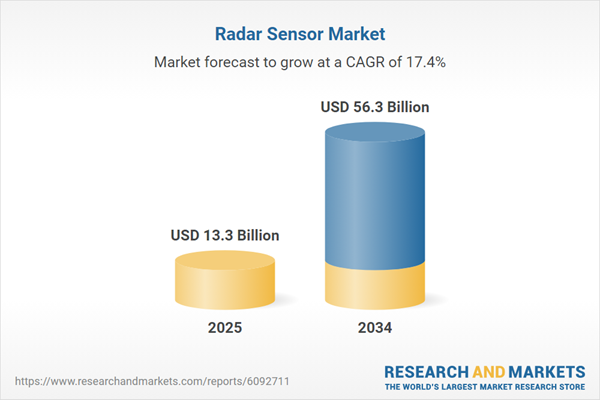Quick Takeaways
-
Rapid Market Growth: The Radar Sensor Market is projected to soar from USD 13.3 billion in 2025 to USD 56.3 billion by 2034, driven by a robust 17.4% CAGR.
-
Key Drivers of Demand: Major growth factors include advancements in Advanced Driver-Assistance Systems (ADAS), applications in smart cities, and increasing military and defense use.
-
Technological Advancements: Integration with AI and machine learning and development of high-resolution, cost-effective sensors are enhancing performance and expanding market applications.
- Challenges Ahead: The market faces hurdles such as high technology costs and the need for standardization, which may limit adoption across various sectors.
Radar Sensor Market Growth Projections
The Radar Sensor Market is on track for substantial expansion. By 2034, its value will rise to USD 56.3 billion, a remarkable increase from USD 13.3 billion in 2025. This growth translates to a compound annual growth rate (CAGR) of 17.4%. Key sectors driving this growth include automotive advancements, particularly in advanced driver-assistance systems (ADAS), as well as applications in smart cities and defense. Radar sensors offer precise object detection and distance measurement, making them essential for safety in vehicles and urban environments. However, challenges such as high costs and a lack of standardization could hinder progress.
Future Applications and Opportunities
Looking forward, radar sensors will enhance urban living and public safety. Cities will leverage these sensors for traffic management and resource optimization, contributing to smarter infrastructure. Moreover, integration with artificial intelligence and machine learning will further improve their capabilities. Smaller, cost-effective radar sensors are also anticipated to gain traction in consumer electronics and industrial automation. As these technologies evolve, various sectors including aerospace and defense will see increased implementation. Despite ongoing hurdles, the future of the radar sensor market remains bright, promising a more connected and safer world.
Discover More Technology Insights
Learn how the Internet of Things (IoT) is transforming everyday life.
Access comprehensive resources on space and science by visiting NASA.
IoTV1

